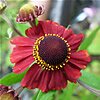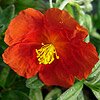A to Z for genus list
Click on genus for plants
- hakonechloa
- helenium
- helianthemum
- helianthus
- helictotrichon
- helleborus
- hesperantha
- heuchera
- hydrangea
- hypericum
- hyssopus
Key to symbols
H
hakonechloa

A mound of gently arching, golden variegated grassy foliage. Looks good in a container. Quite slow growing. Would prefer fairly lime-free soil.
helenium
These are wonderful plants especially for the second half of summer. They send up masses of stems of daisy flowers, some from as early as July, but most from August. If they are regularly dead-headed they will flower for months, almost until the first frosts of autumn. Not only do they cheer us up but they are a valuable source of nectar for bees and butterflies. They seem to do best in fairly moisture-retentive soils in sun. Harmful if eaten, sap may be an irritant to the skin. Ready mid May.

Robust stems of yellow daisy flowers from July to early autumn.

Dark green leaves form a basal rosette with sturdy stems of yellow daisy flowers for weeks from July.

Another good red form, possibly slightly larger flowers than the norm.

Rich dusky red flowers with maroon centres which do not fade with age, for weeks from July. Regular dead-heading will prolong the flowering period.

Streaky orange daisy flowers from June to early autumn.

Yellow daisy flowers overlaid with dark orange and an orange-brown centre from mid-summer to autumn.
helianthemum
Commonly called ‘Rock roses’ and form small shrubs with an abundance of flowers in summer. They need to be cut back (but only into the soft wood) after flowering to keep their shape.

Green foliage, with a flat habit. Covered in deep yellow flowers for months in summer.

Grey foliage with coral pink flowers. One of the larger spreading Helianthemums. Always popular when seen in its full floral glory!

Green foliage, spreading habit. Yellow flowers with dark centres. Long flowering.

Low growing green foliage, with orange flowers and darker centres in midsummer. Can look slightly scruffy after winter, but soon recovers in spring.

Compact plant, with good red flowers and green foliage.

Grey foliage with flame-orange flowers. A show stopper!

Grey foliage, with deep, rich pink flowers in summer.

Soft pink flowers and darker centres over green foliage, makes a good mound.

Upright plant with small leaves and yellow flowers in summer.

A very low growing Helianthemum, summer sunset-orange flowers with a darker, almost red centre, for weeks in summer.

Grey foliage with bright yellow flowers.

Grey foliage with double pink flowers.

Prostrate stems of silver foliage form a ground-hugging mat, yellow flowers in summer.

Grey foliage, white flowers with yellow centre.

Cathy who works on the nursery, found this seedling in her garden and she has named it after her mother. Soft yellow flowers with a darker eye. Compact and long flowering.

Grey foliage with pink flowers.

Grey foliage with primrose yellow flowers.
helianthus

Very strong growing perennial sunflower with sturdy stems of large, showy yellow flowers in late summer, early autumn. Just seems to clump up with us, not spread vigorously like some other Helianthus.
helictotrichon

An attractive grass, with stiff glaucous foliage that radiates out from the base. Arching awns on 90 cm stems.
helleborus
The beauty of their flowers on a cold winter's day is so uplifting. They are best grown in not too dry a situation. All hellebores are poisonous.

Slightly nodding heads of flowers in February to April. Grown from seed so various colours from white, yellow, pink and red.
HESPERANTHA
Its Iris-type leaves belie the fact that it does best in moisture retentive soils and certainly flowers best if planted in full sun. The flowers open on upright spikes during the autumn.

Strap-like green leaves send up spikes of smaller white flowers from September until the first frosts.

Iris-type leaves with spikes of deep, rich pink flowers in autumn.

Spikes of good sized red flowers. An improved version of Hesperantha coccinea.

Larger flowers and a beautiful sugary pink.

Lovely large softest pink flowers from September until the first frosts.
heuchera
These must be one of the most valuable foliage plants for the front of the border, but the secret seems to be that they like decent soil that is neither too wet or too dry! New cultivars are being brought out the whole time with a variety of leaf colours and shapes. We only grow a few varieties, but they have all proved themselves easy to grow with us in sun or shade.

Golden foliage with blood red veins which are more prominent at certain times of the year. Spikes of white flowers from the end of April.
Metallicy-purple foliage forms a good foil for the dainty spikes of rosy-red flowers from spring to summer. (PBR)
Bright lime-green foliage. (PBR)

Wonderfully darkest purple foliage makes a wonderful foil with spikes of tiny cream flowers. (PBR protected)

Makes an attractive mound of ruffled, deepest maroon foliage with silvery markings, and spikes of small maroon and green flowers, from midsummer. (PBR protected)

Hummocks of maroon-purple rounded foliage. Thin spikes of rosy-pink flowers in summer. Only a few.

Forms a clump of evergreen scalloped shaped foliage. Spikes of brilliant dark red flowers for weeks, from May.
Attractive yellow foliage overlaid with brick red in spring, which changes to solid green in summer. Dainty spikes of ivory flowers in summer. (PBR)
HYDRANGEA

We have this planted in the garden and even though crowded out by herbaceous, it still drew a lot of comments last year. A showy shrub when covered in large round clusters of cream flowers, for weeks during summer. Shelter from cold drying winds. Can also be grown in a large container. Prefers a moist soil.
hypericum

Glaucous leaves with large pale primrose-yellow flowers in summer. Makes an attractive mound, covered all over in flowers.

Very flat, creeping plant, with red buds opening to small yellow flowers for weeks. A useful late summer and autumn flowering plant for the rockery.
HYSSOPUS

Hyssop. This herb forms a dwarf shrub with aromatic foliage and short spikes of blue flowers, for months in summer.

